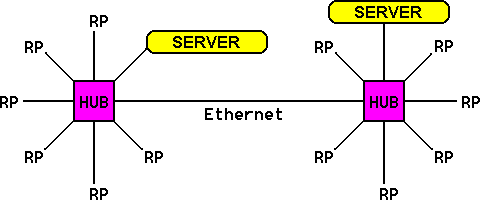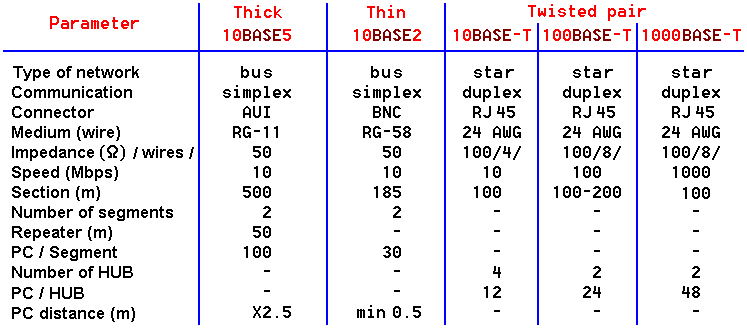3.6.3. PC in the network |
The term PC network usually implies a LAN configuration realized by one of these topologies. It can be implemented as HOST configuration with a PC as a Unix work stations or terminals. For HOST can choose more powerful computer that is not a PC kind. Such an organization is suited to perform a multitude of tasks and related services from multiple users to use the same software and file system support such as accounting and finance companies or institutions and the like.
Smaller organizations and organizations of diverse businesses is suitable for client-server network architecture PCs connected via e.g. NOVELL NETWARE network operating system, which will be used to display the base LAN network system. It was designed to run on any IBM PC compatible computer (processor type xx386 and more powerful), and supports a variety of mixed topology networks, workstations with different operating systems and overall leading hardware is not the manufacturer of LANs. Until recently, over 50% of the world market of local PC network was based on the application of NOVELL NETWARE network operating system designed to connect the 5, 10, 25, 50, 100, 250, 1000 work stations, depending on the version, supports MS-DOS, Windows, Macintosh OS, OS/2 and UNIX workstations so you can subdivide each data file and use a common network resources, in the most powerful version allows you to automatically compress long unused data and WAN networks, has a software solution 'print server' support, the ability to integrate into the host network computers and support different languages. From today's perspective, it seems that the giant quite dilapidated. Linux - a small penguin, taking an increasing share of the pie, it is much cheaper and some free distributions.
In small firms until recently dominated the bus network topology via thin coaxial cable to connect the computer to cheap versions (cheapnet), modified or extended bus topology using HUB with elements of the star topology is shown in next Figure.
 |
|
| Figure 3.6.8 The modified bus topology. |
HUB is a special device for wiring to transfer electrical signals in the 'Star topological structure. Network shown in the Figure above is essentially divided into two working groups of computers. This configuration enables the connection of separate units and cheaper due to the use PTT connection lines connecting to a HUB. Larger institutions stellate commonly used topologies that can scale as needed smaller stellar structures (extended star). In addition to the rate requirements are higher and better use communication cables and network devices.
Bus topology based on thin coaxial cable, despite the low cost of implementation (cheapnet), is not everyone happy network administrators to malfunction due to the characteristics of its cable or faulty reasoning inevitably leads to failure of the entire system. Price drop networking devices for star-topology (hub and a switch) has been completely superseded busbar topology in local networks.
Example I
The parameters of the system network with different network topologies.

|
| Table 3.6.9 Characteristics of different concepts of network systems. |
Bus topology allows coaxial cable length of 185 m to 500 m depending on cable type, and the use of a repeater can be increased by several times due to its characteristics to regenerate and amplify signals. Topology using the HUB allows distances between individual elements of the network up to 100 m, and the distance between the HUB can be enhanced by using a REPEATER. HUB is essentially a wiring junction. Connecting multiple HUB can get largest gap between end workstations, but not more than the multiplication factor shown in the table (number of hubs in the hierarchy). Wiring in the 'Star' topology is UTP (Unshielded Twisted Pair) or STP (Shielded Twisted Pair) type, or simplified unshielded or shielded twisted pair communication, as described in Chapter 3.6.4.
Sometimes the HUB, represented a relatively complex and expensive communication device. Technological development of the price is the cost of other components that serve came negligible. Therefore, it is better for network system used a star topology, the more you can use the same wiring systems for the upcoming speed 1000 Mbps when using UTP cable category C5e least. Besides the star topology is more resistant to damage cables. Termination means the end of one cable, one direction, not a drop of the system as in the case of coaxial connections. It's one of the reasons why the bus topology is further developed for the higher speeds. Today, the new network is generally designed in the 'Star' topology with UTP wiring, regardless of size. Some ADSL devices, for example, typically contain switch with several ports for UTP cabling and allows the user to design a small independent computer network two or more computers with no additional network equipment.
Instead HUB to connect to prefer devices that can analyze traffic through junction called SWITCH. The main difference in this paper is that the HUB received information from one computer sends to all the other computers connected to it, regardless of whether they were familiar or not, while SWITCH analyzes and remembers where the data are intended, and sends them only the computers that have been sent. In this way directs and accelerates traffic through the device. Besides the above better devices of this type can be automatically shut down a port if the institution in this direction in communication failure caused damage to the cable or network (communication) card in your computer. In this way, functionality, resistance to failure and security network system significantly increased.
|
Citing of this page: Radic, Drago. " Informatics Alphabet " Split-Croatia. {Date of access}; https://informatics.buzdo.com/file. Copyright © by Drago Radic. All rights reserved. | Disclaimer |